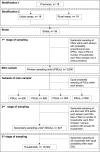Factors associated with stunting among children 0 to 59 months of age in Angola: A cross-sectional study using the 2015-2016 Demographic and Health Survey
- PMID: 36962819
- PMCID: PMC10021435
- DOI: 10.1371/journal.pgph.0000983
Factors associated with stunting among children 0 to 59 months of age in Angola: A cross-sectional study using the 2015-2016 Demographic and Health Survey
Abstract
Stunting among children under five years of age is a serious public health problem globally, with life-long consequences to health, well-being, and productivity. Stunted growth has complex and multifactorial causes, reflecting the interaction of a broad range of conditions that determine child health. The Angola 2015-2016 Demographic and Health Survey (DHS) collected nationally representative anthropometry for 6,359 children 0 to 59 months of age in Angola, and ascertained exposure to a wide range of child, parental, socio-economic, and geographic variables. This study used a cross-sectional design to identify exposures associated with stunting among children 0 to 59 months of age in Angola, while considering the multifactorial and multi-level causes of stunting. Main outcome was prevalence of stunting, defined as proportion of children with height-for-age Z-score (HAZ) two or more standard deviations below the median. Prevalence of stunting was associated with individual, household, and area-level exposure variables, including child age and sex, birth order, birthweight, diarrhea, maternal and paternal age and education, source of water, sanitary system, and province. In conclusion, prevalence of stunting in Angola is associated with several factors previously described in the literature. Stunting is associated with exposures at the distal, intermediate, and proximal levels, in line with the framework on the causes of childhood malnutrition. This study identifies opportunities for interventions at multiple levels to decrease prevalence of stunting among children in Angola. Main limitations of this study are the potential for survival bias and residual confounding.
Copyright: © 2022 Paulo Renato Correa. This is an open access article distributed under the terms of the Creative Commons Attribution License, which permits unrestricted use, distribution, and reproduction in any medium, provided the original author and source are credited.
Conflict of interest statement
The authors have declared that no competing interests exist.
Figures



References
-
- United Nations Children’s Fund (UNICEF), World Health Organization (WHO), International Bank for Reconstruction and Development/ The World Bank. Levels and trends in child malnutrition: key findings of the 2021 edition of the joint child malnutrition estimates. Geneva; 2021.
LinkOut - more resources
Full Text Sources
